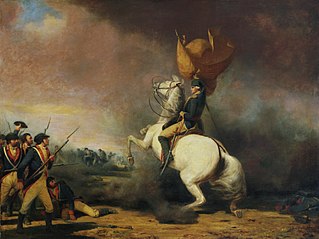 W
WThe Battle of the Assunpink Creek, also known as the Second Battle of Trenton, was a battle between American and British troops that took place in and around Trenton, New Jersey, on January 2, 1777, during the American Revolutionary War, and resulted in an American victory.
 W
WFort Lee Historic Park is located atop a bluff of the Hudson Palisades overlooking Burdett's Landing, known as Mount Constitution, in Fort Lee, New Jersey. Native Americans appear to have lived in the area for thousands of years before the arrival of Europeans. The bluff was the site of George Washington's 1776 encampment opposite Fort Washington at the northern end of Manhattan. Fort Lee is named for General Charles Lee. The site is a reconstruction of the encampment including the blockhouse, battery, quarters as well as a visitors center. It is part of Palisades Interstate Park.
 W
WThe Ambush of Geary, also known as the Amwell Skirmish, was a skirmish of the American Revolutionary War fought on 14 December 1776 in Amwell Township of Hunterdon County, New Jersey. Cornet Francis Geary, the leader of a company of dragoons, was shot in an ambush set up by local militiamen led by Captain John Schenck.
 W
WThe Battle of Iron Works Hill, also known as the Battle of Mount Holly, was a series of minor skirmishes that took place on December 22 and 23, 1776, during the American Revolutionary War. They took place in Mount Holly, New Jersey, between an American force mostly composed of colonial militia under Colonel Samuel Griffin and a force of 2,000 Hessians and British regulars under Carl von Donop.
 W
WThe Battle of Millstone, also known as the Battle of Van Nest's Mill, was a skirmish that occurred near the mill of Abraham Van Nest in Weston, New Jersey on January 20, 1777, during the American Revolutionary War. A British foraging party was flanked and driven off by forces composed mostly of New Jersey militia, depriving the British of their wagons and supplies.
 W
WThe Battle of Princeton was a battle of the American Revolutionary War, fought near Princeton, New Jersey on January 3, 1777, and ending in a small victory for the Colonials. General Lord Cornwallis had left 1,400 British troops under the command of Lieutenant Colonel Charles Mawhood in Princeton. Following a surprise attack at Trenton early in the morning of December 26, 1776, General George Washington of the Continental Army decided to attack the British in New Jersey before entering the winter quarters. On December 30, he crossed the Delaware River back into New Jersey. His troops followed on January 3, 1777. Washington advanced to Princeton by a back road, where he pushed back a smaller British force but had to retreat before Cornwallis arrived with reinforcements. The battles of Trenton and Princeton were a boost to the morale of the patriot cause, leading many recruits to join the Continental Army in the spring.
 W
WThe Battle of Trenton was a small but pivotal American Revolutionary War battle that took place on the morning of December 26, 1776, in Trenton, New Jersey. After General George Washington's crossing of the Delaware River north of Trenton the previous night, Washington led the main body of the Continental Army against Hessian auxiliaries garrisoned at Trenton. After a brief battle, almost two-thirds of the Hessian force was captured, with negligible losses to the Americans. The battle significantly boosted the Continental Army's waning morale, and inspired re-enlistments.